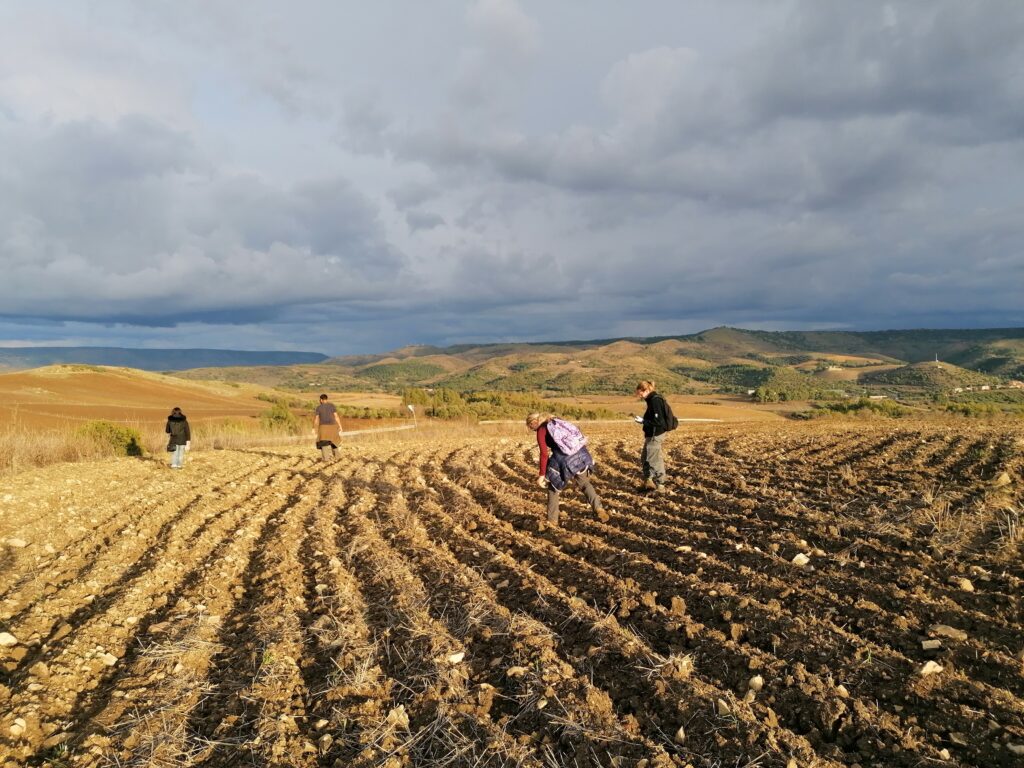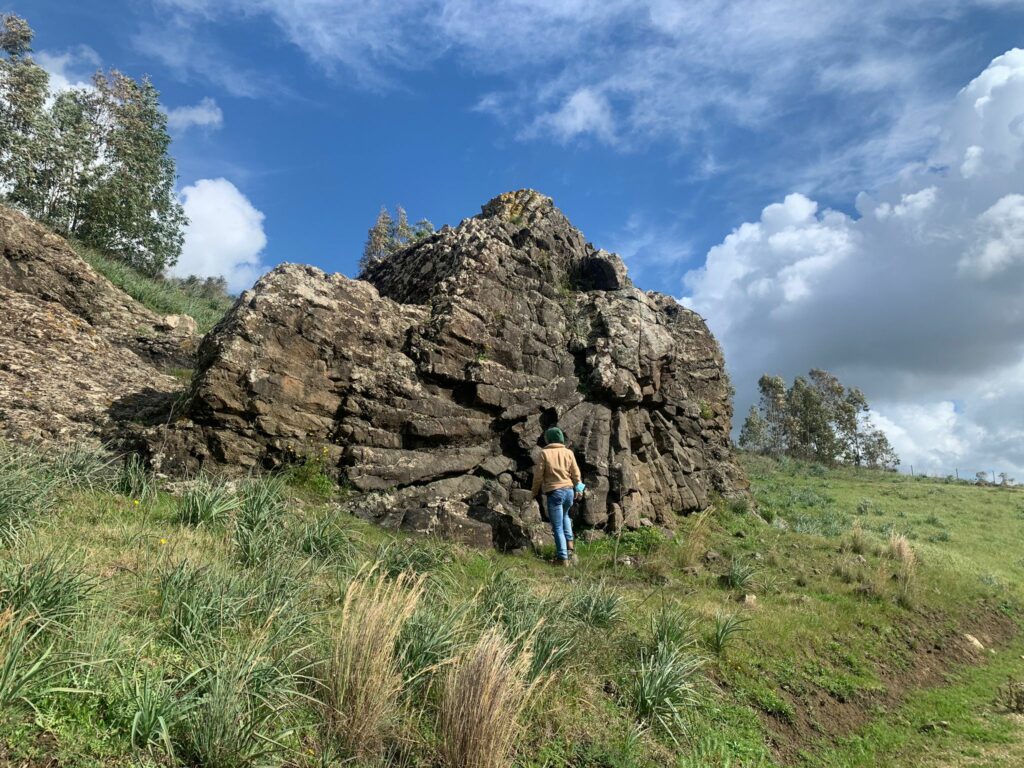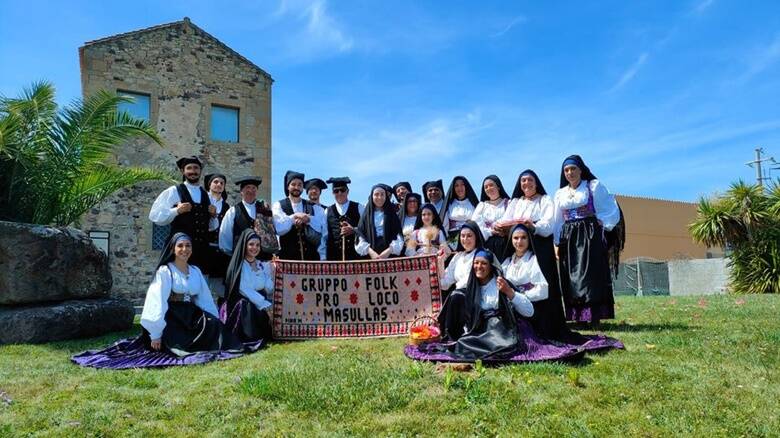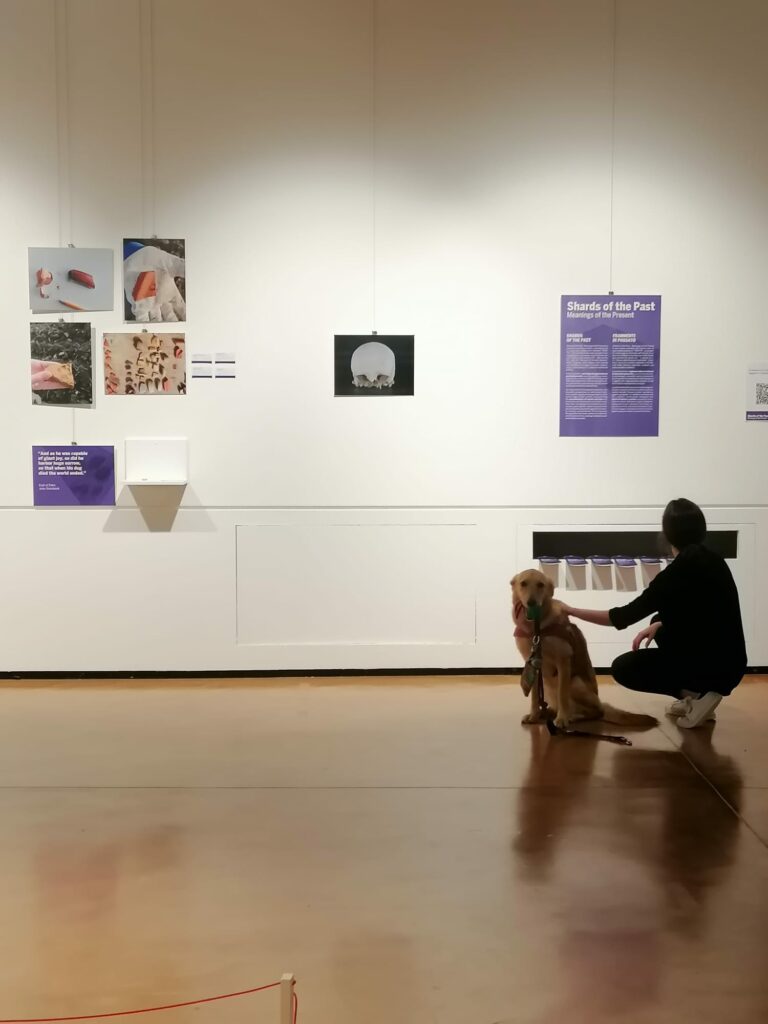By Mauro Puddu, Marie Curie Fellow at Ca’ Foscari University of Venice
Going beyond notability requires defining the boundaries of the specific world in which something, or someone, is held notable. It’s often noted that Sardinia’s insular nature has been used to both establish a world outside its boundaries and one within. While it cannot be denied that the narratives of ancient and modern Sardinia have been influenced by androcentric and elite-oriented perspectives, it’s important to recognize that Sardinia is a world where many women, although distanced from political power, hold significant prominence within their communities. One such remarkable figure is Signora Mariachiara Perria.
Signora Mariachiara Perria, hailing from the rural town of Masullas in central-west Sardinia, has played a crucial role in uncovering the stories of the women and men who worked the cereal fields of rural Sardinia under Roman rule. These narratives, regularly overshadowed by grand tales of emperors and governors, monumental buildings and statues, offer nuanced insights into the ancient world.
What is discussed here is not solely Mariachiara Perria’s story per se. This is also a story of the peripheries, where significant events often take a back seat to those in more central locations due to a Western-centric bias of interest. Moreover, the story of Signora Perria is a chance to reflect more in general about the archaeology of Sardinia in relation to its gender dimension. An online search starts this process of reflection.
The top article for the online search “Sardinian archaeologists” is an article from the official website of the Regione Sardegna entitled “The Father of Sardinian Archaeology”, an homage to archaeologist and politician Giovanni Lilliu, a prolific writer who excavated for the first time an entire nuraghe – megalithic Bronze Age tower systems – Su Nuraxi di Barumini, now a UNESCO World Heritage Site. No women archaeologists are listed in the top 100 results. But we know that the internet is extremely race-and-gender biased. This bias, quite surprisingly, persists even when adapting the previous search to its linguistic feminine version, “Archeologhe Sarde.” Despite this, numerous women have contributed significantly to Sardinian archaeology, albeit with less recognition. One such figure is archaeologist Antonietta Boninu, renowned for her achievements in the field as the scholar who ‘discovered the Domus‘ (Sardinia’s Neolithic graves dug in the rock), ‘the queen of Santu Antine‘ (one of the best preserved nuraghi).
Antonietta Boninu
Antonietta Boninu, who during her career covered the crucial role of Director of the Soprintendenza Archeologica per le Province di Sassari e Nuoro, she contributed significantly to the study of the relationships between Africa and Sardinia, while working close to the local communities of several municipalities, amongst which Porto Torres and Torralba. She also led on the opening of a Centre of Restoration in Li Punti, north Sardinia, to take care of and preserve the statues of Monti Prama, found in the municipality of Cabras, west Sardinia, in the 1970s.
However, uncovering the contributions of women archaeologists often requires persistent effort due to systemic biases. In the words of archaeologists Dyson and Rowland:
Sardinia has remained a place where a single, highly productive scholar like Giovanni Lilliu could dominate the archaeological and historical academic communities for decades. (Dyson & Rowland 2007: 12).
Antonietta Boninu’s career is notable once we shift focus away from male centric perspectives. Similarly, scholars like Donatella Salvi, Rossana Martorelli, and Donatella Mureddu – to quote just a few of them – have significantly advanced our understanding of Sardinian archaeology, through the investigation of, respectively, the rural necropolis of Pill’e Matta, the necropolises and urban sites of Cagliari, and more. Moreover, emerging scholars like Elisa Pompianu and Rosana Pla Orquín have recently directed their efforts towards systematically highlighting women’s presence and challenges in the past, tackling either androcentrism and gender bias in current archaeological practice in Sardinia (Pompianu 2022), or the visibility of women in the ancient funerary practices (Orquín 2022).
In this context, I would like to go back to Signora Mariachiara Perria, the woman mentioned at the beginning of the article, whose keen observations led to the discovery of an ancient necropolis during her youth. Her persistence in alerting authorities and safeguarding the site led to its official excavation, unearthing valuable artifacts and insights into Sardinia’s past.
Mariachiara Perria
Mariachiara Perria was born in Masullas, where she spent all of her life. Her story is also the story of Masullas and of the broader region, Parte Montis, that falls in the most fertile area of Sardinia, for this reason being historically exploited by colonial powers like Carthage, the Roman Empire, and more recently the Reign of Piedmont.

Fig. 1. The rural territory of Masullas, west-central Sardinia, during an archaeological survey.
Masullas is a small town of just 1,070 inhabitants, located in a valley at the bottom of a complex of low and wide hills, historically cultivated for cereals (Fig. 1), at the southwestern slope of the Arci mountain, a source of obsidian since prehistory. Its people have lived in a tight relationship with the naturalistic and archaeological elements sparse in its territory. Known for its intense volcanic activity, for instance, the town and its rural territory are dotted with numerous rocks emerging from the soil. The people of Masullas have had a regular relationship with them, named them, and used them as landmarks for their practices. One of such stones, known for being the biggest Lava Pillow formation in Europe, the andesitic Megapillow of Gutturu Forru (Fig. 2), over 3 metres high and over 22 m long, is known to the inhabitants of Masullas as Sa Perda e Su Soli (the Sun Stone) and used to be where young people in the town met and played.

Fig. 2. The andesitic Megapillow of Gutturu Forru, Masullas, facing the Roman period necropolis on whose excavation took part Mariachiara Perria.
This landmark is located right at the northern bank of the provincial road 44 (SP44). Opposite to it, on top of the hill on the southern side of the same road that takes from Masullas to the neighbouring town of Gonnostramatza was the rural house of the family of Mariachiara Perria. This made her particularly observant of the people of the two towns. From the top of that hill, she was in control of the area, and often, while playing in the fields near her parents’ house, she would notice the movements of people coming to visit them, or of the farmers moving from one field to the other. It is from that hill that already in the late 1980’s, she noticed an unusual movement of unfamiliar people, at unconventional times of the day, mainly right after sunset or even at night, in an area too close to her parent’s fields and vineyards, where no one had reason to be.
Investigating as a young kid what was happening in the valleys near her house, Mariachiara Perria understood that people coming regularly in the late evenings were on some dubious business. Indeed, one morning in the spring of the early 1990s’ she went to check that area, just 10/15 m south of her family’s vineyard, she saw something new: the top-soil was missing in several parts of a roughly 40 sq metres area. And in correspondence with those patches of missing soil, stone slabs that she had not seen before were exposed. She noticed, getting close to them, that several stone slabs were aligned as if to create a cover of something underneath. She soon understood that those were graves. What Mariachiara Perria was looking at were the graves of a necropolis installed during the Roman imperial phase. The necropolis was named of Sa Mitza Salida – Sardinian for a source of stagnant salty water.
She spoke about what she saw, at night and in the morning, to her parents, and from that moment on Signora Perria started her new mission: stopping more illegal visits to that necropolis and notifying the authorities of what she had just discovered.
It is thanks to her insistence and spontaneous surveillance of the site at night that ill-intentioned people stopped visiting the site and disturbing the graves in search of precious objects. And it is thanks to her persistence that the community of Masullas sent communications to the Soprintendenza Archeologica della Sardegna, whose administrators decided to tackle the issue of the exposure and dangerous visibility of the necropolis by setting up an official archaeological excavation. Between 1994 and 1997, the excavation of the necropolis of Sa Mitza Salida, directed by Donatella Mureddu, took place. This unearthed 54 graves, containing 73 buried individuals and over 200 objects used as grave goods. Signora Perria took an active part during the excavation of the necropolis, together with other citizens of Masullas (Fig. 3), as a community volunteer and easily became knowledgeable on how to dig stratigraphically.

Fig. 3. A group of citizens of Masullas dressed in the local traditional dress in the background of one of its Medieval churches.
The contribution of Signora Perria to the local archaeology, and the story of the necropolis of Masullas, does not end with the excavation. She continued to tirelessly press the local and regional authorities to have the results of the excavation both published and exhibited to the public of Masullas and beyond. After over 10 years of oblivion, it is indirectly thanks to her insistence that I started, as a student of archaeology at the University of Cagliari, studying the grave goods from Masullas in 2007, then and still stored in the deposits of the National Archaeological Museum of Cagliari.
Shards of the Past
I finally met Signora Perria in 2020 during the archaeological survey part of the EU funded IDENTIS archaeological project that I organised together with the students of the University of Venice and the University of Ferrara to contextualize the necropolis of Sa Mitza Salida within the broader territory. It is thanks to her good memory and burning passion that, during the survey, we could locate with precision the necropolis, completely covered and protected by the vegetation. And it is due to her inspiring passion that the necropolis is now part of an exhibition on the multiple and individual identities of the past and of the present, organized in collaboration with the Museum of Broken Relationships.
The exhibition, “Shards of the Past, Meanings of the Present”, inaugurated in Venice in August 2023 (Fig. 4), is, while I write, traveling towards Masullas, the town hosting the site where it was conceived for the first time. This exhibition puts the archaeology of Masullas, objects and stories of the present in dialogue through contributions from both the Museum of Broken Relationships and the people of Masullas. A connected PhD project by University of Brighton PhD candidate, Ilenia Atzori has supported this and highlights the interconnectedness of past and present, bridging cultures and generations. The pictures of the necropolis, the memory of it, objects from around the world and everyday objects from Masullas will finally be reunited in Signora Perria’s world, a world of which she has been, since the 1980s, notable beyond measure.

Fig. 4. Two visitors at the “Shards of the Past” exhibition, held in Venice in August 2023.
Despite facing obstacles and biases, these women in archaeology persist in their quest to amplify the voices of the past. Their efforts remind us that every excavation, every discovery, is a collaborative endeavour involving diverse voices and perspectives. In commemorating the active role that women from peripheral communities have had in safeguarding the past, and the achievements of women archaeologists, we honor not only their individual legacies but also the collective memory of Sardinia’s rich heritage. It is through stories like that of Signora Perria’s that we glimpse the complexities of the past, access its diverse voices and are reminded that spontaneous actions taken at crucial times can be more meaningful than professional planning. Not everyone can be or has to be designated as the ‘father’ of a discipline. Stories like this can help us pave the way for a more inclusive and equitable future in archaeology and in our understanding of the human past.
Biography
Mauro Puddu is a Marie Skłodowska-Curie postdoctoral fellow at Ca’ Foscari University of Venice, specialising in the archaeology of the body and of identity in the ancient Mediterranean. He is interested in the material aspects of the lives of those people who did not have a voice in shaping history but who, with their efforts, contributed to create major power structures. His research delves particularly into the history of marginalised and subaltern individuals – women, migrants, slaves – of Sardinia under Rome’s occupation, and attempts to measure the impact of such study on our current society. His research questions are inspired by being a field archaeologist in Mola and PCA in London, and by participation in archaeological fieldwork in Jericho Palestine, Dubai, and southern Italy.
Bibliography
Dyson, S. L., & Rowland, R. J. (2007). Archaeology and history in Sardinia from the Stone Age to the Middle Ages: Shepherds, sailors, and conquerors. University of Pennsylvania: Museum of Archaeology.
Guirguis, M., & Orquín, R. P. (2022). “More Than A Woman”: Riflessioni Sulla Visibilità Delle Donne Nelle Necropoli Sarde Del I Millennio Ac. Cuadernos de Prehistoria y Arqueología de la Universidad de Granada, 32: 173-198.
Pompianu, E. (2022). Morire donna in età punica a Villamar (Sardegna): tombe, corredi e gestualità funerarie: 129-150.
‘L’archeologa che scoprì le Domus’, 4 November 2020, Sassari website: https://www.lanuovasardegna.it/sassari/cronaca/2020/11/04/news/l-archeologa-che-scopri-le-domus-1.39502424 [accessed 24 April 2024].
‘Giovanni Lilliu, the father of Sardinian archaeology’, Sardegna Virtual Archaeology website: https://virtualarchaeology.sardegnacultura.it/index.php/en/archaeological-sites/periodo-nuragico/villaggio-nuragico-di-su-nuraxi/detailed-sheets/4315-giovanni-lilliu-padre-dell-archeologia-sarda [accessed 24 April 2024].
‘La scomparsa dell’archeologa Antonietta Boninu.’ 5 November 2020, Attilio Mastino website: https://www.attiliomastino.it/index.php?option=com_content&view=article&id=343:la-scomparsa-dellarcheologa-antonietta-boninu&catid=41:archivio&Itemid=64 [accessed 24 April 2024].
‘Shards of the Past’, Ca Foscari University of Venice website: https://www.unive.it/pag/48310/ [accessed 24 April 2024].
This post is part of a series in which speakers of the session “(In)Visbile Women in History of Archaeology” of the Annual Meeting of the European Association of Archaeologists 2023 publish their presentations. The posts will be published simultaneously in German and English. The German version of this post can be found on the blog of the project AktArcha at https://aktarcha.hypotheses.org/6632.
